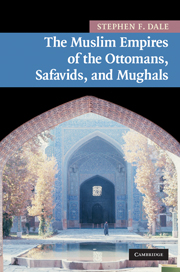Book contents
- Frontmatter
- Contents
- List of illustrations
- List of maps
- Preface
- Languages and transliteration
- Introduction
- 1 India, Iran, and Anatolia from the tenth to the sixteenth century
- 2 The rise of Muslim empires
- 3 The legitimacy of monarchs and the institutions of empires
- 4 The economies around 1600
- 5 Imperial cultures
- 6 Golden ages: profane and sacred empires
- 7 Imperial culture in the golden age
- 8 Quests for a phoenix
- Conclusion
- Glossary
- Dynastic lists
- Bibliography
- Index
1 - India, Iran, and Anatolia from the tenth to the sixteenth century
Published online by Cambridge University Press: 05 October 2014
- Frontmatter
- Contents
- List of illustrations
- List of maps
- Preface
- Languages and transliteration
- Introduction
- 1 India, Iran, and Anatolia from the tenth to the sixteenth century
- 2 The rise of Muslim empires
- 3 The legitimacy of monarchs and the institutions of empires
- 4 The economies around 1600
- 5 Imperial cultures
- 6 Golden ages: profane and sacred empires
- 7 Imperial culture in the golden age
- 8 Quests for a phoenix
- Conclusion
- Glossary
- Dynastic lists
- Bibliography
- Index
Summary
Introduction
Founders of the Ottoman, Safavid, and Mughal empires established their states in territories long characterized by political fragmentation, religious distinctions, the flowering of Greco-Islamic philosophy, the pervasive influence of Iranian administrative traditions and cultural norms, and Turco-Mongol military dominance. It is impossible to comprehend either the continuity or the novelty of these three empires without both being aware of these legacies and also understanding how they affected the histories of northern India, Iran, and Anatolia in the centuries prior to the founding of the Ottoman state in the early fourteenth century and the Safavid and Mughal states two centuries later.
The decline and eventual destruction of the ‘Abbasid Caliphate (750–1258) was the first of two fundamental, interrelated changes that altered the political landscape of these contiguous regions between the tenth and sixteenth centuries. In the eighth century, Muslim rulers governed a vast multi-ethnic, religiously diverse empire stretching from Spain to Central Asia; by the tenth century ‘Abbasid Caliphs had lost control of Baghdad, their capital, as well as more distant Muslim-ruled territories. While the ‘Abbasids retained their status as the legitimate leaders of the Sunni Muslim world, in the mid-tenth century the Buyids (r. 945–1055), a Shi‘i dynasty from northern Iran, occupied Baghdad and its adjacent territories, while independent Muslim dynasts, usually known as sultans, controlled most of the former provinces of the Caliphate.
- Type
- Chapter
- Information
- Publisher: Cambridge University PressPrint publication year: 2009



